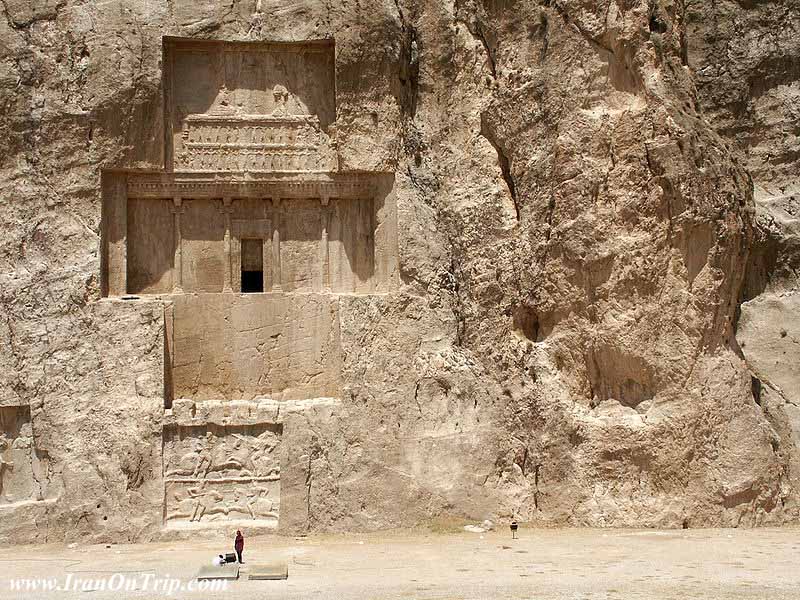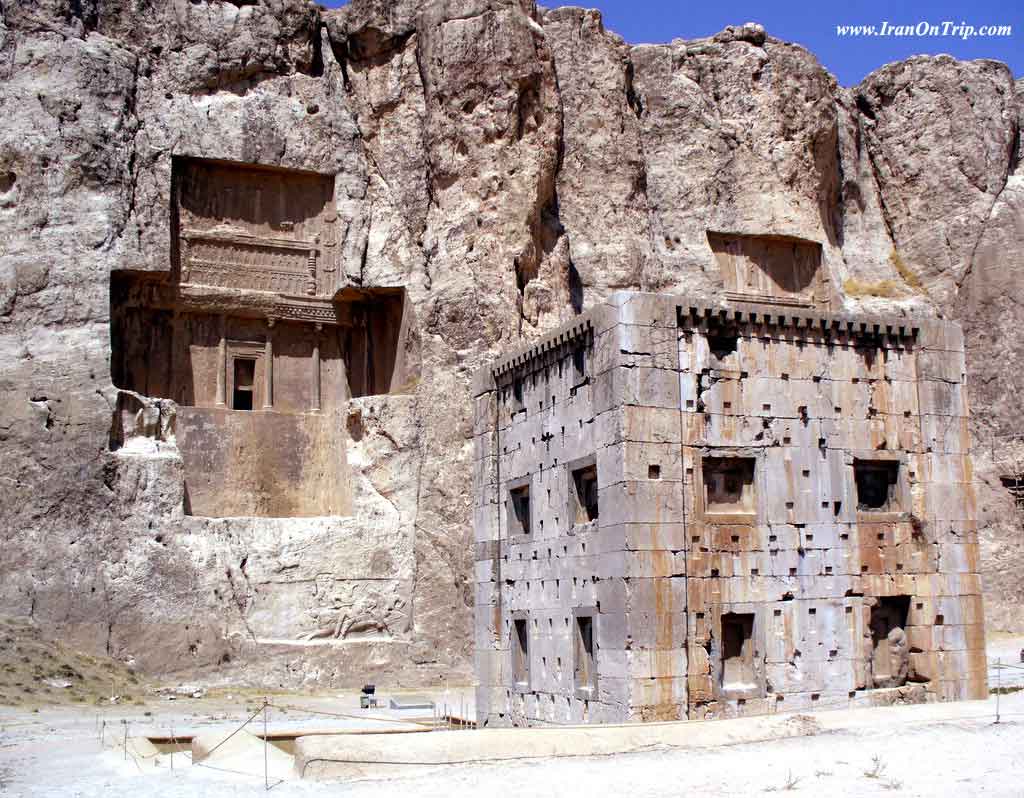Naghsh-e Rostam

Naqsh-e Rostam is a site believed by archaeologists to have been a cemetery for Persepolis, where Achaemenid, Parthian and Sassanid royalty were laid to rest.Located about 3-4 kilometers northwest of Persepolis in Iran’s Fars province, the site contains funerary related works belonging to the Elamite (second millennium BCE), Achaemenid (550-330 BCE) and Sassanid (226-651 CE) eras.
The only surviving monument from the pre-Achaemenid period is a relief which was almost completely obliterated when the court scene of Bahram II (276-293 CE) was carved over it.
The remnants of the scene show an attendant standing behind two deities seated on layered thrones resembling coiled snakes.
Hewn out of a cliff high above the ground are four Achaemenid tombs reputed to have belonged to Xerxes, Darius I, Artaxerxes and Darius II.
According to the Greek historian Ctesias, the tomb of Darius I was in a cliff face that could be reached only by means of an apparatus of ropes.
The tombs of the later Artaxerxes above Persepolis were modeled on those at Naqsh-e Rostam. The openings in the massive tombs lead to the funerary chambers, where bones were stored after vultures picked them clean.The carvings of Artaxerxes’ tomb are considered unique examples of the art of stone carving which was at its peak during the reign of this monarch.
The reliefs above the openings are similar to those at Persepolis with the kings standing at the Zoroastrian fire altars supported by figures representing the subject nations below.
Facing the cliff is the cube of Zoroaster, a square tower with reinforced corners that stands on a three-stepped base. The structure is built of light-colored stone with false windows made of dark stone and the walls are marked with inscriptions cataloguing Sassanid victories.
An identical monument, Zendan-e Sulaiman, was built at Pasargadae. The purpose of these towers is not known, but it has been proposed that they were either royal tombs, depositories for objects of dynastic or religious importance, or Achaemenid fire temples although the possibility of the latter has been ruled out as there are no outlets for smoke or gases.
A 400-year period of internal and foreign conflicts between the Achaemenids and Sassanids left no room for innovation; as a result, Sassanid stone carvings are generally replicas of those found in Bishapur and Firouzabad.The eight Sassanid stone reliefs cut into the cliff beneath the facades of the Achaemenid tombs depict scenes of imperial conquests and royal ceremonies.
The oldest relief carved near the Elamite relief depicts the appointment of Ardashir I (224-241 CE) by Ahuramazda.Ardashir’s successor, Shapur I (241-272 CE), was the next to carve his “Victory over the Romans” on a relief standing near Darius’s tomb.
The third relief, carved over the Elamite relief, shows Bahram II (276-293 CE) with members of his family and court.In the fourth century, and perhaps at the beginning of the fifth century, five other reliefs with jousting scenes were carved below the Achaemenid tombs.
The Naqsh-e Rostam structures have been built from white and grey Limestone without the use of mortar.
It is believed that Persians were the first to use colors to decorate stone carvings. A particularly striking feature of Naqsh-e Rostam stone carvings is the use of color; many of the site’s inscriptions and carvings are covered with Lapis lazuli.
Evidence shows that the carving of Darius had a lazuline beard and mustache, black hair and eyeliner, red eyes, lips and shoes as well as colorful robes, although the passage of time has left the colors at Naqsh-e Rostam unstable.Currently pending approval by UNESCO for inclusion on its World Heritage list, Naqsh-e Rostam is a unique and beautiful reminder of Persia’s rich artistic history.

Achaemenid tombs
Four tombs belonging to Achaemenid kings are carved out of the rock face at a considerable height above the ground.
The tombs are known locally as the 'Persian crosses', after the shape of the facades of the tombs. The entrance to each tomb is at the center of each cross, which opens onto to a small chamber, where the king lay in a sarcophagus. The horizontal beam of each of the tomb's facades is believed to be a replica of the entrance of the palace at Persepolis,
One of the tombs is explicitly identified by an accompanying inscription as the tomb of Darius I the Great (c. 522-486 BC). The other three tombs are believed to be those of Xerxes I (c. 486-465 BC), Artaxerxes I (c. 465-424 BC), and Darius II (c. 423-404 BC) respectively. A fifth unfinished one might be that of Artaxerxes III, who reigned at the longest two years, but is more likely that of Darius III (c. 336-330 BC), last of the Achaemenid dynasts.
The tombs were looted following the conquest of the Achaemenid Empire by Alexander the Great.
Sassanid reliefs
Seven over-lifesized rock reliefs at Naqsh-e Rustam depict monarchs of the Sassanid period.
The investiture relief of Ardashir I (c. 226-242):
The founder of the Sassanid Empire is seen being handed the ring of kingship by Ahura Mazda. In the inscription, which also bears the oldest attested use of the term 'Iran' (see "etymology of 'Iran'" for details), Ardashir admits to betraying his pledge to Artabanus IV (the Persians having been a vassal state of the Arsacid Parthians), but legitimizes his action on the grounds that Ahura Mazda had wanted him to do so.
The triumph of Shapur I(c. 241-272):
This is the most famous of the Sassanid rock reliefs, and depicts Shapur's victory over three Roman emperors, Gordian III, Valerian and Philip the Arab.[1] A more elaborate version of this rock relief is at Bishapur.
The "grandee" relief of Bahram II (c. 276-293):
On each side of the king, who is depicted with an oversized sword, figures face the king. On the left stand five figures, perhaps members of the king's family (three having diadems, suggesting they were royalty). On the right stand three courtiers, one of which may be Kartir. This relief is to the immediate right of the investiture inscription of Ardashir (see above), and partially replaces the much older relief that gives Naqsh-e Rustam its name.
The two equestrian reliefs of Bahram II (c. 276-293):
The first equestrian relief, located immediately below the fourth tomb (perhaps that of Darius II), depicts the king battling a mounted Roman soldier.
The second equestrian relief, located immediately below the tomb of Darius I, is divided into two registers, an upper and a lower one. In the upper register, the king appears to be forcing a Roman enemy from his horse. In the lower register, the king is again battling a mounted Roman soldier.
Both reliefs depict a dead enemy under the hooves of the king's horse.
The investiture of Narseh (c. 293-303):
In this relief, the king is depicted as receiving the ring of kingship from a female figure that is frequently assumed to be the divinity Aredvi Sura Anahita. However, the king is not depicted in a pose that would be expected in the presence of a divinity, and it hence likely that the woman is a relative, perhaps Queen Shapurdokhtak.
The equestrian relief of Hormizd II (c. 303-309):
This relief is below tomb 3 (perhaps that of Artaxerxes I) and depicts Hormizd forcing an enemy (perhaps Papak of Armenia) from his horse. Immediately above the relief and below the tomb is a badly damaged relief of what appears to be Shapur II (c. 309-379) accompanied by courtiers.
Archaeology
In 1923, the German archaeologist Ernst Herzfeld made casts of the inscriptions on the tomb of Darius I. Since 1946, these casts have been held in the archives of the Freer Gallery of Art and the Arthur M. Sackler Gallery, Smithsonian Institution, in Washington, DC.
Naqsh-e Rustam was excavated for several seasons between 1936 and 1939 by a team from the Oriental Institute of the University of Chicago, led by Erich Schmidt.
In Order To Have a Virtual Tour please Click here
Your feedback is extremely valuable to us, and will be useful for others.
So let us to have your comments.
.....
.....
.....

.jpg)



























